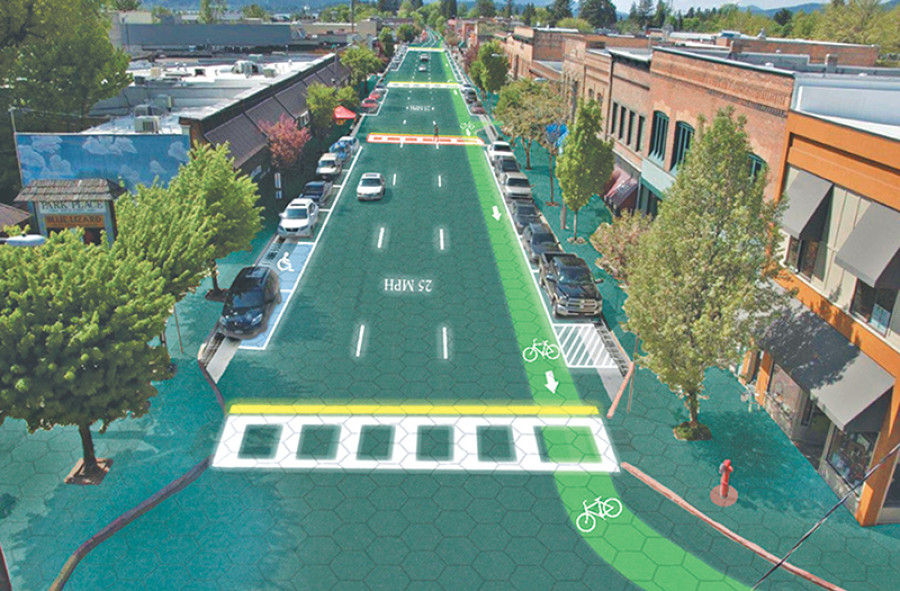Opinion
Right to the streets
They are building roads that connect cities, and not city streets that connect people
Barsha Chitrakar
Revelations that Kathmandu’s air is one of the most polluted in the region no longer raises eyebrows. Combustion of household wastes and vehicular emissions are said to be the major reasons behind the air pollution. Is the way our roads are being constructed really to blame for the mess? Speaking at a talk programme hosted by Design Dabali, environmentalist Bhushan Tuladhar stated that roads and streets were two different entities. Roads run between two distant points, and streets are paved roads in each of these cities. Essentially, streets connect people and act as a social place, while roads connect cities for travel.
Pursuant to this idea, our policymakers have formulated two separate road standards: National Road Standards (NRS) that deal with national highways and feeder roads and National Urban Road Standards (NURS) that deal with urban roads. So far so good. Although highways and feeder roads are generally devoid of human settlements, they are one major characteristic of our urban areas because of the ribbon development that takes place along these road sections. This has resulted in the intermingling of roads and streets in certain places, like the newly constructed Koteshwor-Kalanki section, for instance. To deal with this, the NURS suggests that both the NRS and NURS should be followed for such road stretches.
Fair enough!
(Mis)guided development
Now let’s take a look at the much-talked-about (for all the wrong reasons) Koteshwor-Kalanki road section. This road stretch intersects the definition and parameters of the Strategic Roads Network (SRN) and the Local Roads Network (LRN). The design principles which an urban road or street should follow as stated by the NURS, like providing space for seating areas, ramps, kiosks, landscaped areas and vehicular stops, have been neglected during the construction. And what we see today is a large stretch of paved road, just that.
Herein lies the problem: All the roads essentially have been perceived from a single lens of ‘strategic roads’. Hence, we are building roads that connect cities but not people, and that attract vehicles but not pedestrians adding to vehicular emission. We are building roads that promote hard landscapes which results in more storm water drain-off, not green areas that retain water and recharge the groundwater table. The green landscape that could have acted as a buffer space to reduce the carbon content and harmful gases is consumed by concrete roads, and people-centric streets have been overshadowed by car-dominant roads.
The road widening project was initiated in a bid to free the Valley from ever-increasing congestion. Roads were dug, buildings violating the by-laws were ruthlessly dismantled and tress were felled. Dust enveloped the Valley, but development comes at a price, right? Or so the Kathmandu denizens thought and geared up to battle the momentary dust.
A few years down the line, the road widening project kept getting expanded, from one urban section to another, and the dust only increased. And the traffic congestion, it only increased several-fold.
Better late than never
This thus poses a question: Do wider roads reduce traffic congestion? The answer is an outright no. Many developed countries have realised this, albeit after their own share of road-widening projects followed by more traffic congestion and inefficient urban growth and environmental degradation, and the list just goes on. With experiences worldwide, this is almost proven that wider roads attract usage of private vehicles. Hence, a wider road is not an end in itself like many of us would like to think.
Once we have our wide roads, we need to have other measures in place—multimodal transport, for one. This mode of transportation promotes multiple modes of transport — bicycles, electric vehicles and walking. Bicycle lanes and footpaths should have equal space in the right of way of urban roads which are predominantly occupied by vehicles. Secondly, promoting public transportation is only crucial when one-third of the total trips is done by public vehicles. Since we have such wide roads, designating a road section for bigger buses will be good. While these corrective measures will enhance mobility, vehicular emission will also be reduced to a great extent.
Let’s get back to the Koteshwor-Kalanki section. It seems that one section on either side of this road can be designated for bigger buses. The footpaths barely give space for three persons to walk abreast. There is talk of amending the design of this road stretch. When that is done, I hope the builders will go through the NURS and build an urban street. We have too many roads, maybe it is time we build streets. We have given too much space for cars, it is high time we gave space for people who have a right to the city, a right to clean air and a right to the streets.
Chitrakar is an architect and an urban planner




 5.4°C Kathmandu
5.4°C Kathmandu










%20(1).jpg&w=300&height=200)

